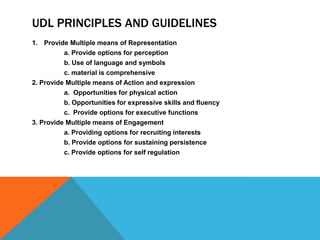UDL
- 2. UDL PRINCIPLES AND GUIDELINES 1. Provide Multiple means of Representation a. Provide options for perception b. Use of language and symbols c. material is comprehensive 2. Provide Multiple means of Action and expression a. Opportunities for physical action b. Opportunities for expressive skills and fluency c. Provide options for executive functions 3. Provide Multiple means of Engagement a. Providing options for recruiting interests b. Provide options for sustaining persistence c. Provide options for self regulation
- 3. IMPLEMENTING UDL Try to predict potential barriers that students will encounter during a lesson. Being prepared to handle these barriers with the students.
- 4. IMPLEMENTING UDL ŌĆó Use Hands on activities! ŌĆó Be encouraging for the students. ŌĆó Use group activities so High level achieving students can help low achieving students
- 5. WITH UDL MORE STUDENTS ARE: ŌĆó Engaged in With UDL, more students are: ŌĆó Engaged in their own education. ŌĆó Learning in greater breadth and depth. ŌĆó Achieving at higher levels. ŌĆó Motivated to continue learningtheir own education. ŌĆó Learning in greater breadth and depth. ŌĆó Achieving at higher levels. ŌĆó Motivated to continue learning





